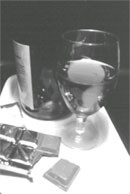Hearty duo!
 the much maligned chocolate can actually act as a powerful tool against heart attacks. Andrew L Waterhouse, Joseph R Shirley and Jennifer L Donovan from the department of viticulture and enology, University of California, Davis, us report that chocolate contains potent chemicals that neutralise substances directly implicated in coronary heart disease. And to top it, Waterhouse and colleagues go a step further and advocate consumption of another taboo. To extract the maximum benefits from chocolate, they suggest a glass of red wine to wash it down (Lancet, Vol 348, No 9030).
the much maligned chocolate can actually act as a powerful tool against heart attacks. Andrew L Waterhouse, Joseph R Shirley and Jennifer L Donovan from the department of viticulture and enology, University of California, Davis, us report that chocolate contains potent chemicals that neutralise substances directly implicated in coronary heart disease. And to top it, Waterhouse and colleagues go a step further and advocate consumption of another taboo. To extract the maximum benefits from chocolate, they suggest a glass of red wine to wash it down (Lancet, Vol 348, No 9030).
Chocolate has a mixture of more than 400 compounds, including stimulants like caffeine, theobromine plus tyramine and phenyl tyramine, which produce alertness and slightly higher blood pressure. Chocolates also contain phenolics, chemicals that are potent antioxidants for low density lipoproteins that deliver cholesterol to the cells.
Cholesterol, a soft fatty substance that forms part of our cells cannot dissolve in blood and needs to be carried around by something else. Lipoproteins are its means of transport. Low density lipoproteins (ldls) deliver cholesterol to the cells and high density lipoproteins (hdls) carry any excess back to the liver for safe disposal. If, however, there are too many ldls and too few hdls, surplus cholesterol gets deposited on or in the artery walls. The walls become pitted and blood channels become narrow. Phenolic compounds boost hdl levels thus helping artery walls from getting clogged.
Waterhouse and colleagues tested a range of confectionary products for their phenol content. They found that one piece of a 40 gm milk chocolate had almost the same amount of phenol (about 205 mg) as a glass of red wine (210 mg). Plain dark chocolate contained even more phenol (8.4 mg/gm) than the milk variety (5.0 mg/gm). A hot cup of chocolate with about 7.4 gm (two spoonfuls) of cocoa would have as much as 146 mg of phenol. Cocoa powder is thus a very potent antioxidant. In fact, it even exceeds the antioxidant potential of red wine
